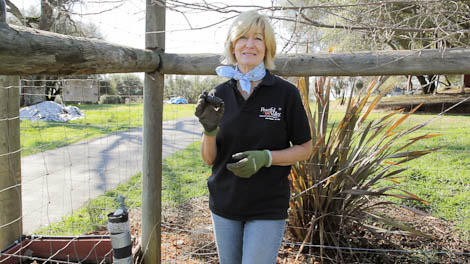Water pressure and water flow are key to answering that basic gardening question, How do you get water to the plants?
We all know how to water plants.You can: hand water (time consuming), move an oscillating sprinkler around (wastes water as it sprays through the air, and haven't we all forgotten to turn off the sprinkler?)
Best of all though, for:
- steady supply of water to your plants
- water conservation
- convenience
How to Measure Water Pressure
 The first thing to figure out is how much water pressure you have. Then you can move on to looking at water flow. It's easy to check your water pressure. Turn off all appliances or hoses that would drain from that water source. Screw on a water pressure gauge, and turn on your faucet. The gauge will show your pressure in Pounds per Square Inch, commonly abbreviated as psi.
The first thing to figure out is how much water pressure you have. Then you can move on to looking at water flow. It's easy to check your water pressure. Turn off all appliances or hoses that would drain from that water source. Screw on a water pressure gauge, and turn on your faucet. The gauge will show your pressure in Pounds per Square Inch, commonly abbreviated as psi.
How to Measure Water Flow
Have you seen those abbreviations GPM and GPH when you're reading about irrigation? In our video Tricia explains that those mean Gallons Per Minute and Gallons Per Hour.What are Your Gallons Per Minute?
There's an easy way to establish the GPM from your water source -- all you need is a bucket and a stop watch. Watch the video to see how Tricia does it. Five gallon buckets often hold more than 5 gallons, so Tricia pours 5 one-gallon jugs of water into the bucket.
Five gallon buckets often hold more than 5 gallons, so Tricia pours 5 one-gallon jugs of water into the bucket.  Tricia marks the 5 gallon line in the bucket.
Tricia marks the 5 gallon line in the bucket.  She puts the empty bucket under the spigot, gets out her stop watch, turns the spigot on full blast, and times how long it takes the water to reach the 5 gallon mark. In a nifty piece of animation, our video shows the formula to apply. 5 (for the number of gallons) divided by the number of seconds to reach the 5 gallon mark = gallons per second. Multiply that number by 60 = gallons per minute. Multiply again by 60 for gallons per hour. To take full advantage of the capacity of 1/2" poly tubing you will need 200 gallons per hour.
She puts the empty bucket under the spigot, gets out her stop watch, turns the spigot on full blast, and times how long it takes the water to reach the 5 gallon mark. In a nifty piece of animation, our video shows the formula to apply. 5 (for the number of gallons) divided by the number of seconds to reach the 5 gallon mark = gallons per second. Multiply that number by 60 = gallons per minute. Multiply again by 60 for gallons per hour. To take full advantage of the capacity of 1/2" poly tubing you will need 200 gallons per hour.
Making Choices About Your Irrigation System
Look at your water pressure (psi) and water flow (GPH) and what you need to water (see our Drip Irrigation video for your equipment choices). Now you can put together the mix of: * pressure regulators * poly tubing with emitters * drip tape * soaker hoses * emitterlines that are right for your water supply and landscape.Do You Need a Pressure Regulator?
If your pressure is over 30 psi, you need a pressure regulator to ensure your drip emitters don’t pop out, or emit more water than you want. Drip emitters are rated in gallons per hour at a specific pressure. For example, mini-sprinklers can have a flow ranging from 4.4 to 30.5 gallons per hour depending on the pressure and the sprinkler model.Choosing the Right Pressure Regulator
Poly tubing requires 25 to 30 psi to run well. Drip tape, soaker hoses, and emitterlines need much lower pressure at 10 psi. Choose your pressure regulator to produce the pressure you need for the type of system you are running -- either drip tape and soaker hoses, or poly tubing with emitters. For drip tape, choose a pressure regulator that reduces pressure to 10 psi. For poly tubing with emitters and soaker hoses, choose a pressure regulator that reduces pressure to 22-25 psi. Some of our pressure regulators are labeled for hi flow. Use them if your flow is over 8 GPM. 
For more information about drip irrigation, we recommend the clear and useful book, Drip Irrigation for Every Landscape. Measure your water pressure and water flow, and you're on your way to planning your drip irrigation!

